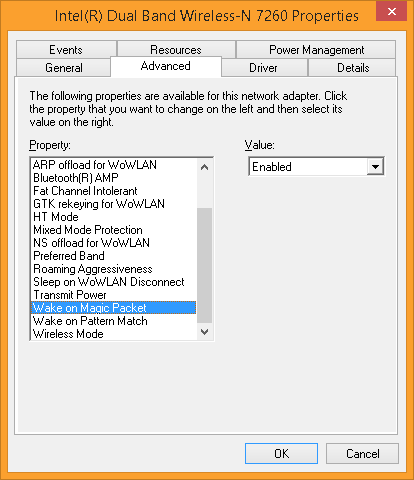152
19
My wireless adapter (Intel Dual Band Wireless-N 7260) has two settings in Device Manager which I cannot explain.
Wake on Magic Packet
Wake on Pattern Match
After a bit of research, I found this Microsoft Technet article which defines the feature as follows:
Defines if a network adapter is enabled to wake a computer on the magic packet.
This rather cryptic description is a bit low on details. Can anyone help?
I would prefer that my laptop not be woken up remotely under any circumstances. I've disabled Allow this device to wake the computer on the Power Management tab, but these settings appear to be separate. My assumption is that I can set these two settings to Disabled without negative consequences. Is that right?

6Note that based on my experience, WoLAN/WoWLAN most likely require a firmware (BIOS/UEFI) option to be enabled in addition to the adaptor setting. For instance, my laptop's wireless adaptor has this option offered by Windows, but no corresponding option exists in the firmware, and I can't seem to use WoWLAN regardless of the adaptor setting. You should check in the firmware, too, and disable it if really unwanted (just to be sure!). – underscore_d – 9 years ago
@underscore_d, good point. I've tried a few times to make this work, but I've never actually seen a computer turn on in response to a network packet. Now that I think about it, you'd also have to make sure the network card is powered when the computer was "off" which might be another setting somewhere. – JPhi1618 – 9 years ago
@JPhi1618 Yeah, there are a lot of variables/dependencies. I should clarify my anecdote, my official firmware doesn't offer this option... I flashed it with a custom version with everything unlocked, mostly for laughs, but obviously not everything is really supported - case in point being the new WoWLAN setting. I've not dug into the details, but since the motherboard, firmware, wireless card, and possibly OS (judging by the existence elsewhere of 'always online' OEM services, etc.) all have to agree - suffice it to say that you need the right combination of pieces! – underscore_d – 9 years ago
This seems odd. Who has enough experience to know what every other property in that list relates to(Fat Channel Intolerant?!?), but doesn't know what Wake on LAN is? – superphonic – 9 years ago